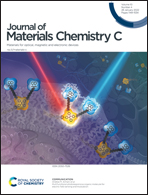Designed 3D heterostructure with 0D/1D/2D hierarchy for low-frequency microwave absorption in the S-band†
Abstract
Developing a low-frequency tunable microwave absorber for the normal use of sophisticated electric devices is an urgent requirement for dealing with electromagnetic pollution. Herein, we report the designed synthesis of a three-dimensional (3D) heterostructure constructed from multidimensional components, namely, MXene/CoNi/N-CNTs (nitrogen-doped carbon nanotubes). A uniform metal–organic-framework (MOF) ZIF-67/Co–Ni layered double hydroxide (LDH) core-shelled structure was first synthesized and then transformed into CoNi/N-CNTs via pyrolysis under a N2 atmosphere. Then, CoNi/N-CNTs were deposited on the surface of 2D MXene by electrostatic assembly to acquire a 3D superstructure nanocomposite. The advantages of low-dimensional components are fully utilized in the unique 3D heterostructure. The 3D conductive network is formed from 1D N-CNTs, and the synergistic effect of multiple loss mechanisms significantly facilitates its microwave absorption (MA) properties. Specifically, the material shows an optimal reflection loss (RL) of −52.64 dB at 3.12 GHz at a thickness of 3.8 mm, and an effective absorption bandwidth (EAB) from 2.8 to 3.52 GHz, which covers the S-band. Importantly, adjustable and efficient MA between the S and C band can be realized by modulating the loads of the CoNi/N-CNTs. Accordingly, the feasibility of designing a hierarchical 3D superstructure from low-dimensional components to deal with electromagnetic pollution can be audaciously predicted.



 Please wait while we load your content...
Please wait while we load your content...